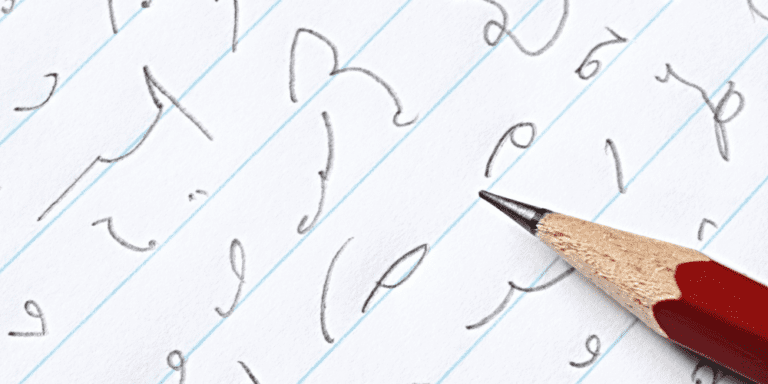If you’ve ever wanted to learn a new and unique skill in order to better yourself or improve your life in some way, there are a few places where you can start. You can learn new exercises or a new instrument, but you could also learn a skill that will help you write and translate long blocks of text more easily when you’re studying or transcribing information.
Shorthand writing is a great way to accomplish these goals, as it helps people all over the world write down long pieces of complex and extensive information easily and quickly.
The technique has a long and storied history, dating all the way back to antiquity in Ancient Greece, and has been used for thousands of years in professions that require speed and accuracy when writing or transcribing.
Although old-form shorthand techniques take years to learn and master, there are new methods of shorthand writing that can be learned in months and are far easier to remember and use in practical situations.
Shorthand writing in history
Historians have noted that the earliest known record of shorthand is found in Ancient Greece, in the Parthenon. There, a slab of marble was found with a writing system different from the rest of the country, in which vowels were frequently omitted and modified scrawling would indicate the use and presence of consonants.
Marcus Tullius Cicero, a Roman politician known for his philosophical works, was a renowned and frequent public speaker.
His slave Tiro may have used a form of shorthand to quickly write down Cicero’s speeches, developed with the use of persuasive writing techniques, so he could record them for posterity and public record.
The art and practicality of shorthand has evolved since the times of Ancient Greece and Rome, and is still in frequent use today. Before typewriters and computers became mainstream, journalists, secretaries, and court stenographers used shorthand writing to quickly transcribe interviews, meeting minutes, and court proceedings.
Even now, court stenographers use an electronic version of shorthand in the form of a stenotype machine, which is similar to a computer keyboard but with less keys.
Any profession which needs to write long speeches or large chunks of information could benefit from using shorthand.
The original shorthand systems
Pitman Shorthand
There are three main types of shorthand when discussing the historical use of shorthand. One of these is Pitman Shorthand, developed by Englishman Sir Isaac Pitman. Although all three of these types of shorthand are outdated now, the Pitman method was the easiest and most useful for the layman for the time period.
Pitman developed his shorthand in the early nineteenth century and used a series of quick lines and geometrical shapes to replace the letters of the alphabet. While many forms of shorthand work based off of the sounds of word, Pitman used the actual letters of the alphabet in his shorthand, which made it the easiest and most versatile writing style for a long period.
Newspaper reporters and phonographers used his style to transcribe important events and speeches of the time, including the highly critical Lincoln-Douglas Debates.
Gregg Shorthand
Gregg shorthand writing was invented by John Robert Gregg nearly fifty years after Pitman shorthand, in 1888. Gregg’s shorthand is based off of cursive and uses a series of elliptical lines bisected by other lines. It’s tougher to learn than Pitman shorthand but is also the most popular shorthand in the United States.
Experts think that Gregg’s system was based on Pierre Herigone’s mnemonic major system. There have been many versions of his shorthand published; most recently in 1988 in Centennial.
Teeline Shorthand
Finally, there’s Teeline shorthand writing, developed by James Hill in 1968. A pupil of the Pitman Shorthand style, Hill developed the style with an eye toward speed and quick learning. Most people in Britain use his shorthand writing system, but it’s easy to change to other languages, like German and Spanish. With Teeline shorthand, it’s possible to write up to one hundred and fifty words per minute.
Learners can also create their own word groupings, which increases comprehension and speed when needed. Teeline also uses the alphabet for his shorthand but improves the process by removing unneeded letters from words, such as silent letters. Many proponents of shorthand in the UK use Teeline shorthand, though a new form of shorthand has emerged in recent years that is quickly challenging its dominance.
Shorthand in a digital age
If you want to learn written shorthand today, the most widely accepted and quickly proliferating shorthand form is Ford Improved Shorthand.
This new style of shorthand writing further improves the technique by sticking closer to the letters of the alphabet and shortening the length of lines. Many proponents of the Ford shorthand writing style believe anybody can learn it within fifteen minutes or less.
The letters of the style are easy to remember and lead to faster writing, alongside better comprehension, and more easily recognizable letters. The other three styles listed above are quite outdated, which led Michael Ford to develop Ford shorthand in 2012.
So is it worth learning shorthand in this age of keyboards and voice-to-text apps on every smartphone?
We think so! Why? If you’re in a classroom environment and need to quickly take down lecture notes, shorthand writing increases the amount of information you can throw down on the page, enabling you to keep pace with the teacher without feeling stressed. In fact, it’s been proven that writing is better than typing for your memory!
If you’re thinking of becoming a writer, shorthand is a fantastic way to ‘exercise’ your brain, is incredibly useful for writing notes, and more.

Writing Exercises: From the Blank Page to Everyday Practice
Engage in creative writing exercises that document and generate ideas, and transform it into a regular practice.
Writing Exercises: From the Blank Page to Everyday Practice
Engage in creative writing exercises that document and generate ideas, and transform it into a regular practice.
